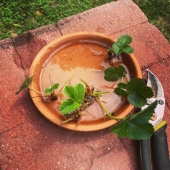




 5
5





 1
1




 2
2





 1
1




 1
1
















Cris Bessette wrote:They definitely spread by stolons.
I started with about five plants a few years ago, now I have hundreds.

'What we do now echoes in eternity.' Marcus Aurelius
How Permies Works Dr. Redhawk's Epic Soil Series
 1
1





 1
1




Kyle Neath wrote:You're correct in your hunch — an individual strawberry plant may only produce for 3-5 year, but any new plants from runners reset that timer. Often people pull the whole "rip up the whole patch and replant" when they keep the strawberries in a contained, linear row under plastic that prevents runners from creating new plants. If you let strawberries do their thing, they'll keep going indefinitely.
 1
1




 1
1




 3
3




 1
1




Miles Flansburg wrote:That is interesting Leora, I wonder if it has to do with the type of strawberry?
Mine have been in the same spot for years and the little ones just keep filling in any small space that they find.

 1
1




 3
3












Joylynn Hardesty wrote:When I was looking into this, I found an article that claimed that ever-bearing strawberries do not spread by stolons, only by seed. So, to compensate for this, return your strawberry scraps to your patch. Strawberry tops, with seeds attached, then you'll always be sprouting new plants from seeds each year to replace the dying plants.




Joylynn Hardesty wrote:When I was looking into this, I found an article that claimed that ever-bearing strawberries do not spread by stolons, only by seed. So, to compensate for this, return your strawberry scraps to your patch. Strawberry tops, with seeds attached, then you'll always be sprouting new plants from seeds each year to replace the dying plants.

|
The happiness of your life depends upon the quality of your thoughts -Marcus Aurelius ... think about this tiny ad:
Freaky Cheap Heat - 2 hour movie - HD streaming
https://permies.com/wiki/238453/Freaky-Cheap-Heat-hour-movie
|




